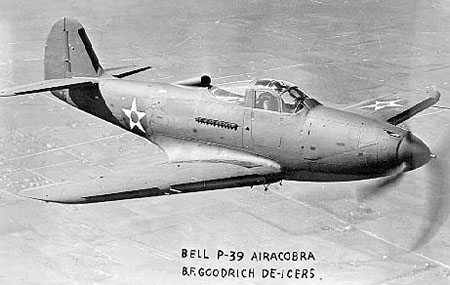![]() The Pacific War Online Encyclopedia
The Pacific War Online Encyclopedia
|
| Previous: P-38E Lightning, U.S. Fighter | Table of Contents | Next: P-40 Warhawk, U.S. Fighter |

Bell P-39D Airacobra
| Crew | 1 |
| Dimensions | 34'0" by 30'2" by
11'10" 10.36m by 9.19m by 3.61m |
| Wing area | 213 square feet 19.8 square meters |
| Weight | 5460-8200 lbs 2480-3700 kg |
| Maximum speed | 368 mph at 13,800 feet 592 km/h at 4200 meters |
| Cruise speed | 245 mph 394 km/h |
| Landing speed | 82 mph 132 km/h |
| Climb rate | 45 feet per second 13.7 meters per second |
| Service ceiling | 32,100 feet 9780 meters |
| Power plant | 1 1150 hp (857 kW) Allison V-1710-35 vee-12 liquid-cooled engine driving a three-bladed propeller |
| Armament | 4 0.30
fixed
wing machine guns 2 0.50 fixed cowling machine guns 1 37mm M4 fixed propeller cannon with 30 rounds |
| External stores | 500 lbs (227kg) bombs
or
62 gallon (235 liter) drop tank |
| Range | 800 miles (1290 km) with 500 lb (277 kg) bomb load 1550 miles (2500 km) ferry |
| Fuel | 72 gallons 273 liters |
| Production | 9588 of all P-39 types to 5/44 at Bell Aircraft Corporation, Buffalo, NY, of which about 5000 went to the Soviet Union. 4900 of these were P-39Qs. |
| Variants |
The P-39C was armed with two 0.30s and two 0.50s in the nose and no wing guns. It was being replaced by the -D by the time war broke out. The P-400 was exported to Australia and the Soviet Union and was equipped with a 20mm cannon with 60 rounds in place of the 37mm. The P-39N/Q had a 1200 hp (895 kW) Allison V-1710-85 engine, giving it a speed of 386 mph (621 km/h) but reducing its range to 650 miles (1046 km). |
In 1937, the U.S. Army Air Corps awarded a pair of contracts for
interceptor aircraft. The contract for a two-engine interceptor
was awarded to Lockheed
for the P-38 Lightning, which
went on to become a successful fighter-bomber in the Southwest
Pacific. The contract for a single-engine interceptor was
awarded to Bell for the P-39 Airacobra, which turned out rather
differently. Although heavily armed and armored
and very
tough, this plane was a
bust in its original design role as an interceptor. However, it
was
very
successful as a ground attack aircraft.
The design was marred by a number of poor decisions. The
turbosupercharger was eliminated due to exaggerated concerns over
the drag from its air scoop, which all but guaranteed that the
design would be a bust as a fighter. The airfoil section for the
wings was also badly chosen, and the tail section was too small
for adequate directional stability. The first prototype flew in
1939 and production
was ordered by the British
in 1940. The first aircraft were delivered
in June 1941 to 601 Squadron, which found the aircraft so
unsatisfactory, due to poor high altitude performance and mediocre
handling, that they failed to make the effort to keep them
serviceable.
Operational
losses of this type
in the Southwest Pacific were extremely high because of its
unusual
engine
placement (behind the cockpit) and 37mm armament, which made
maintenance
difficult. The engine placement also seems to have degraded
the
maneuverability, and made it particularly difficult to recover
from a spin.
The export version of the P-39, the P-400, was an even poorer fighter, and the joke went that a P-400 was a P-40 with a Zero on its tail. However, half of all production of the P-39 went to the Soviet Union, which used it with great success as a ground attack aircraft.
About 60% of American P-39 crews were deployed to the Pacific, a reflection of the low priority given to the theater because of the "Germany First" policy.
 |
 |
 |
References
WW2 Warbirds (accessed 2009-10-15)
The Pacific War Online Encyclopedia © 2007, 2009, 2014, 2016 by Kent G. Budge. Index